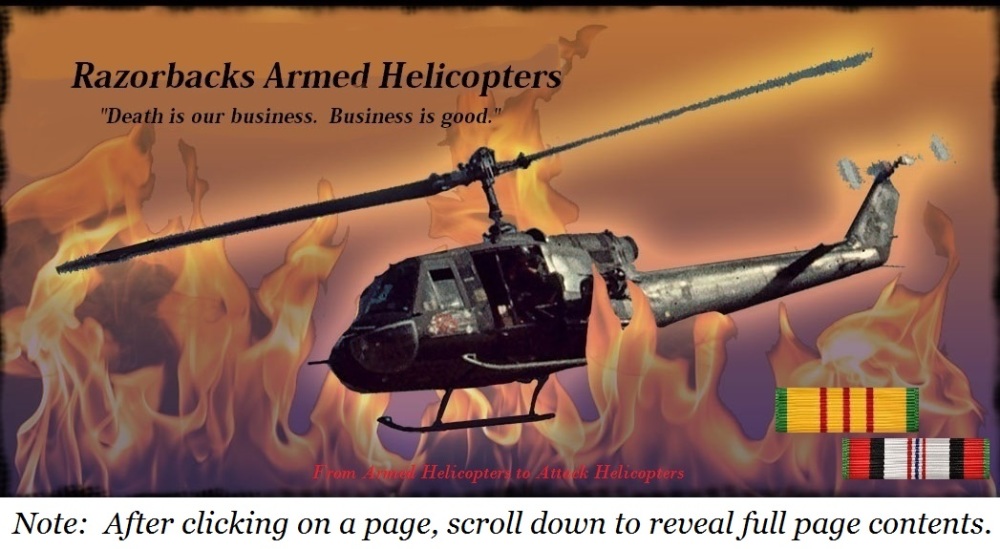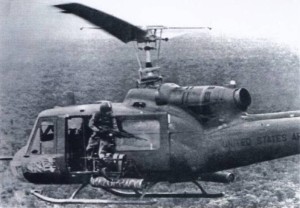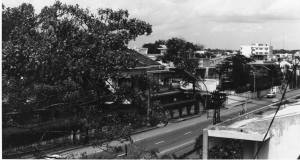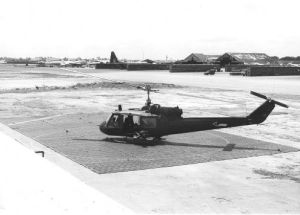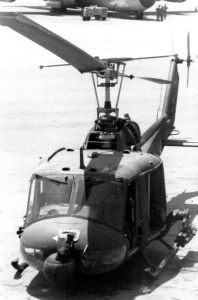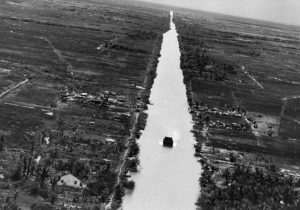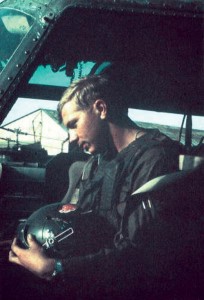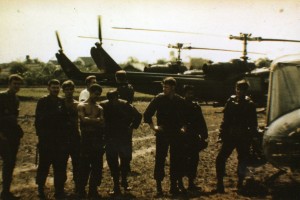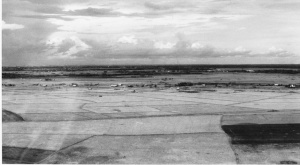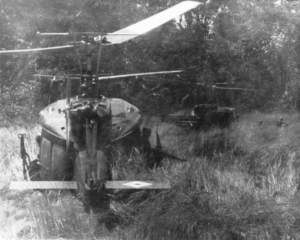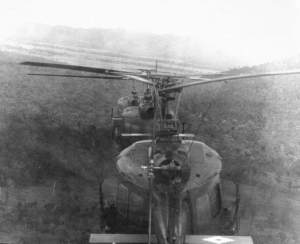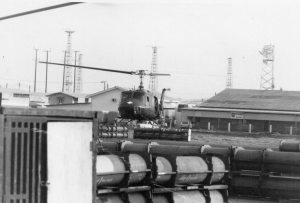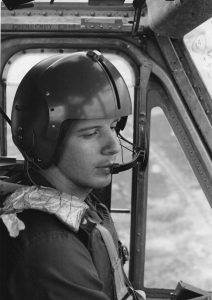The following are articles written by a few former Razorback members for various reasons. These articles are non-fiction and I believe you will find them of interest.
******
Ken Loveless’ Story from the 187th’s website. Courtesy of Ken Loveless
Dear Bob:
I read with interest your letter to the editor and account of the action your unit was involved in near Bien Hoa. I became quite emotionally affected, as I was caught up in that same action – and your account brought back some memories long ago buried in my mind. Suppose it would be best if I could share with you my recollections of that fateful day. You are the first person, other than my crew, that I’ve found who was there and had some idea of the events that day. Possibly I should start by telling you how and why our fire team became involved in your unit’s “ballgame.”
I was Razorback 33 and was flying with Razorback 3_? (Al Cornell) leading a light fire team working alone in the pineapple fields, just west of Saigon (DUC HOA or MUC HOA area). We had made a few attacks on bunkers when we received a call from a USAF FAC flying an 01 Birddog over your area of operations. He told us that the operation was in trouble – he spotted our smoke/explosions – and requested our assistance to help in a re-supply effort. We immediately broke off and headed for your area at top speed, following his directions – soon seeing smoke rising from your LZ and surrounding paddies. Upon over flying your LZ and adjacent rice paddies, we saw a number of burning helicopters, 5 or 7, it’s difficult to remember. I do remember telling the team that “those guys must have been ambushed.” I thought of command detonated mines or artillery rounds in the LZ, something such as that. Upon arriving, the FAX was telling a TOP TIGER ship to wait for my team, as we would accompany him in to re-supply. My plan was to suppress the dike area boundary to the east of the LZ, as it was heavily vegetated, or hit wherever we drew fire on approach. The TOP TIGER ship set up a left base into the rice paddy, landing to the north – without waiting for my team to join up on him. We, the FAC and me, hollowed for him to stop – not go in – yet he continued! Just as he approached the ground, centered in the paddy, he was hit and the ship rolled over. I couldn’t tell if he was hit by a mine or went over as the result of other fire. One thing stuck in my mind – no one was getting out – I saw no one crawl out of the wreckage and no one went in after them. The aircraft was not on fire, so I wanted to get them out of the wreckage – before it burned. We told our wing ship to cover us, we were going in to get them out – granted in hindsight, not very smart – yet we didn’t want them to burn.
We went in, took a close look at the TOP TIGER bird, saw the infantry troopers flat on their stomachs across the area, some pointing to the east dike. As we took this in, our ship took hits, my starboard pod of 24 rockets (we had a “HOG”) was set ablaze and my starboard door gunner took a round through his neck – sending him through the air and almost out the left side. A round had also hit the oil reservoir, as you may remember it was positioned just aft of the firewall and on the right side of the engine. The pressure reservoir split open with a resultant immediate loss of oil pressure. I could see we were next in order of burning ships, and our concern shifted from the TOP TIGER bird to our door gunner. I didn’t know what his condition was, but he was alive and knew we had only seconds left to get him out. Full power/pitch was pulled as we pointed our bird straight for the line of black pajama clad VC lined across the dike firing at will at us some 25 yards away.
The rockets wouldn’t fire, so I raked my hand across the center console to hit the toggle switch, safety wired off, to activate the explosive bolts mounting the rocket pods to the aircraft. They did blow the pods broke off as we climbed out and over the VC. To this day, I don’t know if or how many of the bastards we took with us – I can only hope all was not in vain in that some of them bought it! We turned back west, along the waterway just North of the LZ and made it about two clicks before going in, no further damage to our ship, but our engine was gone – (that engine will run for a short while without oil!) and we wanted our wingman to get our door gunner to the hospital ASAP.
Well, that’s what I saw of that day – the General officer – a BG landed at our ship to see how we made out – then took off to go back and orbit over the area where he then took fire and was hit, along with his aide, the same two you wrote about. That wasn’t very smart of him as well. Shortly after, I went to your base at Tay Ninh. It was there where I bought your officers club a round of drinks after entering covered. I couldn’t tell it was a club! It was also there where I learned from your pilots some more of the story. I was told that the Command and Control had not allowed your guns to hit the area prior to assault – supposedly there were no “enemy” and the LZ was cold. As usual, I was told that the “counterpart” wouldn’t approve suppression of the LZ. Again, if factual – dumb as dirt! How many times has that occurred? I’ve often wondered how many were killed needlessly in the action of that day. I learned a lesson I never forgot on that one – thereafter and on the following tour in Viet Nam as a gun driver, C&C and as the Commander of the 162d Assault Helicopter Company, I never bought that line of bull – always, always, always shot up everything in sight on our assaults – Vietnamese like it or not!! One thing for sure – never an ambush, no burning helicopters in the LZ!
Well, I’ve said a little – “coming out of the closet”, I suppose as the result of your writing. Also please don’t construe my commends to cast a negative light on the efforts of the TOP TIGER aircraft commander, whoever he was, as I hold all my comrades in highest esteem. Just another case of “maybe it didn’t have to happen that way”. Why he didn’t wait will only be known to him and God. So much has been held up inside of me these past 20 years. I’m sure you understand……
Sincerely,
Ken Loveless
******
The Pigs of Saigon
Text & Photos courtesy of Ralph Arneson
The Razorbacks
After 8 months of flying VIPs around what was known as III Corps I found a need to get more involved in the war. My unit, the 120th Aviation Company had a gunship platoon at Saigon Heliport and they needed pilots. I had been down and stayed at the villa on a couple of my days off and preferred the lifestyle to the one which I had at the Long Bin Headquarters. I also felt that the job I was doing was too tame.
For a start we had our own bar, a crude affair which saw a lot of action, the type that only young men left to their own devices could aspire to, sort of a college fraternity house. Booze we got from our very own liquor salesman who rented a container where he could store beer for his other customers, army clubs in Saigon. Music for our parties was supplied by an Australian agent who drank lunch and did his paperwork at our bar as the noise of all the bands practicing at his place was unbearable. So we had it pretty good. The Villa was a three story affair and my own room which I shared with another officer was on the top floor overlooking the main street going into Saigon from the airport.
Cac Mang
Our aircraft were parked most of the time at the main heliport at Hotel 3, Saigon Heliport. Driving out of the heliport after coming in from flying, there were nine of us in the Jeep. We were stopped one time by either General Abrams or Mildren, these were the top 2 generals in Vietnam. He said that he would give us two days to clean up the flight line and the slum we called the villa and then he was going to inspect us personally. It took two days just to get the illegal firearms out of the villa and stored over at the liquor man, Dirty Willy’s place. He never did come and inspect us, but later the higher ups decided that they didn’t need a gunship platoon in Saigon any more.
The unit was first moved to Long Binh, the army headquarters, eventually they were moved from here too. One of the warrant officer urinating over the railing of the second story of the barracks they were billeted and hit a lieutenant coronel on the head, so they spent some time living in tents at the airfield and later sent south to the Mekong Delta to live in trailers with the navy. They got a pet pig that lived under one of the trailers. I had since moved to another unit to fly front seat Cobra.
The stand-by pad
We had three basis missions; a five minute reaction team, a lightship mission, and a sniffer mission. The five minute team of two gunships stood by at a shack between the taxi-way and the runway at Tan Son Nhut Airport. Here we had beds to rest, a television, and the snack bar was close by, across the taxiway. A second team was on 30 minute stand-by at the villa. We worked on a 24 hour on-24 hour off schedule. We flew night, day and all types of weather.
We were sometime called out at night when troops had come in contact with the Viet Cong and needed gunship support. This is hard to describe to someone who has not been there. We held off a few miles to circle and get an understanding of the situation which could take some time. We needed to identify where the friendlies were and then get some light on the situation using a flareship, usually a clapped out DC-3 flown b the Vietnamese Air Force. Coordinating all these units, some working through a translator sometimes two, was a nightmare. The possibility of shooting the wrong troops was always present. All that solved, we could start using rockets, mini-gun, or 40mm grenade. The rockets were not very accurate and had a tendency to wander off. They were not designed for a helicopter but for propeller driven airplanes in WW 2. The two mini-guns could fire straight ahead at 2400 rounds a minute each; in three second bursts. When turning the sight either way it would reach a stop and the gun not pointing into the helicopter would pick up to 4000 rounds a minute. However, these mini-guns were notorious for jamming and it was near impossible to fix them in the air, so there you sat. The door gunners with their M60 machine guns were then used to the max and were probably more effective than the rest of the equipment. The 40mm was pretty effective in certain situations, but you had to walk the rounds on to the target. The concussion was very powerful.
40mm turret on the nose & 14 2.75” rockets
Once the situation was understood we would work the weapons where we where told or until we were short of fuel and had to return.
One night it took so long to get all the information that we were low on fuel and still had not fired, the flare ship didn’t know where to drop. They finally agreed that they should drop where the helicopter rotating beacons were. The flare ship illuminated us all the way back to Saigon airport.
We went out at night with a lightship, a UH-1 with 7 C-130 landing lights arranged together, about a half-million candle power. We flew along the Cambodian border looking for sampans and troops coming into Vietnam, just like they did before TET of 1967 or 68 and attacked Saigon. We sometimes used the lightship for troops in contact but the most memorable time was when we were finished with our mission.
One of the lieutenants wanted to check out how my roommate was doing with his new girlfriend. Our room on the third floor overlooked the main road from the airport to the city centre with big French doors. John hovered level with the balcony and then hit the lights. The bed sheets flew all over the place and the pair were caught in the act. The next night it was my roommate’s turn to fly the light and pay a little visit to the villa, this time a smoke grenade came down in the courtyard. The situation got worst, the villa was shrouded in smoke every night and we all realized where it would lead, riot gas. The nightly visits finally stopped at the villa but one hotel used as a brothel got a visit from a disgruntled customer and got the gas.
One night we were flying along minding our own business and someone shot at us. We returned the favour with rockets. However, coming out of one of the runs we heard and felt a crump in the aircraft, it felt like we had been hit and decided to land at a nearby airstrip and have a look. On final approach the flying pilot said the pedals were getting stiff so we made a running landing to the runway and then everything still being OK we hovered over to the side and shut down. Using flashlights we looked the aircraft over and found nothing wrong until we looked at the transmission cowling near the rotor mast, there was a 2 inch gap! We tried to open the engine compartment but had to take the doors off to do this. Here we found the braces to the firewall ripped off and then noticed that the tail was hanging low. The crew chief looked up the hell hole, under the transmission, and just about s—t, the main beams were nearly torn in two. A classic case of fatigue just minutes from total failure. Later, we were told that the aircraft with the 40mm grenade launchers had to have about 14 pounds of lead put in the tails to get them into the weight and balance window, this might have caused an oil canning effect.
Below is a photo from the west of Saigon. The landing craft that supplied the bases on the canals were always getting hit with rocket propelled grenades, so we had to fly top cover for them while they were between bases. During one period we spent 14 hours of a 24 hour period with the rotors turning. We did 12 hours from 6 AM to 6 PM landing only to refuel, and a dawn recon the next day. You cannot imagine how boring circling over a boat doing about 6 knots is for such a long time. Even with us on top, the VC still managed to pop out of a spider hole a fire off an RPG. On one occasion we landed and picked up a soldier that had been hit while driving a boat on the canal but he died before we could get him to the hospital. By flying with the doors open, the inside of the helicopter was as if it had been sprayed with blood, including the backs of our necks and the windshield.
These were the sad times, but for the most part we had it good. Next episode I will try to remember some more war stories and then move on to civilian life.
The author as a young man in Saigon
You may want to check out the Vietnam Helicopter Pilots Association website. There are lots more war stories there.
More Pigs in Saigon
In a rice paddy after the crash
This photo shows the Razorback crews after a tail rotor failure put one aircraft impaled on a barbed wire metal stake. What happened: the lead aircraft said he was experiencing some odd things happening and elected to land at Muc Hoa, a small runway with refuelling and rearming facilities. He was all right until his airspeed got below 40 knots and the aircraft began to spin on final approach. He cut the throttle and ended up crashing the helicopter on the camp perimeter wire. An iron stake went through the fuel tank. Our aircraft landed 50 meters away and by the time I got there, the crew had gone but the engine was still running in idle. I turned to get back to my own aircraft and noticed a set of prongs sticking out of the ground. It dawned on me that we had landed in a mine field. I yelled to my crewman to look where he was stepping and we lifted straight up and landed in the rice field on the outside of the perimeter. The 30 minute team showed up shortly to get in the photo.
The sniffer mission was done just before dusk or right after dawn for two reasons. First, the wind was usually still and two, people were either making dinner, breakfast, or having a smoke. It had nothing to do with sniffing out urine like was thought. In the helicopter was a box that counted condensation nuclei, dust particles to us common folk. When people make food, smoke a cigarette, or a group of men walking in the jungle they raises dust. A black box counted the density of the particles and the location was registered on a map. The operation used three helicopters; the sniffer, one gunship low and behind, and the last high doing the navigating and marking the hot spots. Later, these spots might be hit with artillery or a long range patrol sent in to check out enemy activity. But again, it could have been an active troop of monkeys or the odd elephant making the dust.
South and West of Saigon
I can remember two of the many sniffer missions we did. West of Saigon was a flat plain of reeds crossed with canals which were made by French engineers many years ago to irrigate the rice fields. We were flying low level, about 50 feet, when I saw people in the grass! There was no reaction from the sniffer. We pulled up and called to find out if they were the South Vietnamese, no they weren’t and we got clearance to fire. We expended everything and then called for artillery. They sent in some South Vietnamese troops to clean up and claimed the body count.
Even flying a gunship can get a little boring sometimes, so I tried flying with another company that did troop insertions for a day. I wanted to get some photos. I was getting some good shots but on short final to the landing zone the commander told me to put the camera down and pay attention in case he got shot. As it turned out we took no fire and I have some of the best photos I took in Vietnam.
These two photos are taken with a 35 mm lens. This makes the aircraft in the first photo appear to be flying almost on top of one another. Actually, the aircraft are not more than one rotor disc away, the normal distance for flying formation in the army at that time. The vertical separation is maintained by keeping the tail rotor gearbox in line with the exhaust pipe. It becomes second nature after a while. The other photo shows the rotor blades coning after using most of the power available due to the load and landing in tall grass destroys most of the ground effect.
The heliport had a lot of activity. Not only were the normal flights of helicopter coming and going, the gunships repositioning to the stand-by area, but there was a number of movements by CH-47s (Chinook) and CH-64s (Sikorski Sky Cranes). Most of the Chinook flights came to pick up jeeps, had been stolen. The Chinook would land and one Jeep would drive out, an hour or so later three Jeeps would drive in and the Chinook would waste no time in leaving. The Sky Cranes would bring in aircraft to the heliport and be taken over to a near-by facility where they were packed in plastic and shipped to the US for overhaul or storage. What is hard to appreciate here is the small size of the heliport, the obstacles surrounding the area, and the number of movement of aircraft.
I had the unfortunate luck of having FOD (foreign object damage) to the compressor while taking off from the heliport. I narrowly missed coming down in the liqueur sales part of the PX. I also missed all of the antennas and wires on the other side of the building and landed in the mud. The general officer I had on board took his shoes off and waded to dry land. The maintenance officer tried later to fly it out but just managed to get further into it.
A Sky Crane with a stripped out Chinook
My other recollection of flying the sniffer was when I had transferred to a Cobra unit at Ben Hoa, this time it was Charley’s turn to give me something to think about. We had finished sniffing the areas we had been assigned that morning and were asked to sniff a square kilometre south and west of Long Than, not that far from the Main Headquarters at Long Bin. I had two Cobras behind me, one low and the high one leading me to the area. We were on the first pass when I saw the fire coming out of a tree line through the right window. I made a sharp turn to the left and a second later the aircraft shook, we were hit. The instruments were gone, but we were still in the air and getting the hell out of there. We landed at Long Than and looked for the bullet hole on the right side but found none. We finally found it on the left side. It had come in along the belly of the aircraft, under the cargo door. It had followed along the fuel tank leaving a brown burn mark without puncturing the tank. It had come in at an angle such that it had pushed the honeycomb aluminium until it hit the wire bundle and the main spar, then stopped. This had caused the instruments to malfunction. But there was a question of the damage being on the left side of the helicopter. I saw the gun on the right? The only explanation I can give is that the helicopter was over a 90 degree bank angle or there was another machine gun that hit me. This was 23 days before I was to leave Vietnam and the army. I made a lot of dentist appointments and stayed away from the company area. I took up watching baseball at my buddy’s hooch in Long Binh. They did catch me a couple of times to fly, but never again on the sniffer.
I left the army in January 1970 and started looking for a job. I had been a pilot for two and a half years and had a little over 1600 hours. Adjusting to civilian life was harder, drinking was a big problem and the welcome home for veterans was pretty cold. My mother told me after a while, sort of joking, that she liked it better when I was in Vietnam, at least she knew where I was at night. She almost always waited up for me to come home.
******
